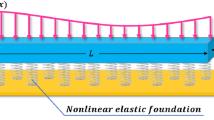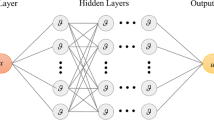Summary
The elliptic paraboloid failure surface criterion (EPFS) is adopted in this paper to describe the failure behaviour of anisotropic bodies. A method is described, based on an inequality-constrained least square problem for the determination of the parameters of the EPFS criterion. After the discussion of the influence of the strength differential effect on the failure behaviour of the material, a neural network learning approach is introduced to the problem of extrapolating the given experimental results beyond the given range of experimental data by establishing an appropriate law of evolution of the failure surface valid for the material up to fracture.
Similar content being viewed by others
References
Theocaris, P. S.: Failure criteria for transtropic pressure dependent materials. Rheol. Acta27, 451–465 (1988). See also: Theocaris, P. S.: The paraboloid failure surface for the general orthotropic material. Acta Mech.79, 53–79 (1989).
Theocaris, P. S.: Failure criteria for anisotropic bodies. In: Handbook of fatique crack propagation in metallic structures. (Carpinteri, A., ed.) pp. I, 3-45. New York: Elsevier 1994.
Theocaris, P. S., Panagiotopoulos, P. D.: Neural computing and artificial intelligence in fracture mechanics. Proc. Nat. Acad. Athens66, 373–400 (1991) (in Greek).
Theocaris, P. S., Panagiotopoulos, P. D.: Neural networks for computing in fracture mechanics. Methods and prospects of applications, Comp. Math. Appl. Mech.106, 213–228 (1993).
Kortesis, S., Panagiotopoulos, P. D.: Neural networks for computing in structural analysis. Methods and prospects of applications. Int. J. Num. Meth. Eng.36, 2305–2318 (1993).
Avdelas, A. V., Panagiotopoulos, P. D., Kortesis, S.: Neural networks for computing in elastoplastic analysis of structures. Mechanica30, 1–15 (1995).
Theocaris, P. S., Panagiotopoulos, P. D.: Generalized hardening plasticity approximated via anisotropic elasticity: A neural network approach. Comp. Math. Appl. Mech. Eng.125, 123–139 (1995) See also: Plasticity including the Bauschinger effect, studied by a neural network approach. Acta Mech.113, 63–75 (1995), and: Hardening plasticity approximated via anisotropic elasticity. The Fokker-Planck equation in a neural network environment. ZAMM75, 889–900 (1995).
Wu, E. M.: Mechanics of composite materials. (Sendeckyj, G. P., ed.), Vol. 2, p. 353. New York: Academic Press 1974.
Mangasarian, O. L.: Solution of symmetric linear complementarity problems. J. Optim. Theor. Appl.22, 465–485 (1977).
Cichocki, A., Unbehauen, R.: Neural networks for optimization and signal processing. New York: J. Wiley 1993.
Ritter, H., Martinez, T., Schulten, K.: Neural computation and self-organizing maps. Reading: Addison-Wesley 1992.
Panagiotopoulos, P. D.: Hemivariational inequalities application in mechanics and engineering. Berlin, Heidelberg, New York: Springer 1993.
Beale, R., Jackson, T.: Neural computing. An introduction. Bristol: Adam Hilger 1990.
Ikegami, K.: An historical perspective of the experimental study of subsequent yield surfaces for metals part II. J. Soc. Mat. Sci.24, 709–719 (1975).
Shiratori, E., Ikegami, K.: Experimental study of the subsequent yield surface by using cross-shaped specimens. J. Mech. Phys. Solids16, 373–394 (1968). See also: Shiratori, E., Ikegami, K., Kaneko, K.: Subsequent yield surfaces determined in consideration of the Bauschinger effect in foundations of plasticity (Sawczuk, A., ed.) Leyden: Noordhoff 1973, and Shiratori, E., Ikegami, K., Yoshida, F.: Analysis of stress-strain relation by use of an anisotropic hardening plastic potential. J. Mech. Phys. Solids27, 213–229 (1979).
Michelis, P. N.: Work softening and hardening behaviour of granular rocks. Rock Mech.14, 187–200 (1981).
Author information
Authors and Affiliations
Rights and permissions
About this article
Cite this article
Theocaris, P.S., Bisbos, C. & Panagiotopoulos, P.D. On the parameter identification problem for failure criteria in anisotropic bodies. Acta Mechanica 123, 37–56 (1997). https://doi.org/10.1007/BF01178399
Received:
Issue Date:
DOI: https://doi.org/10.1007/BF01178399




